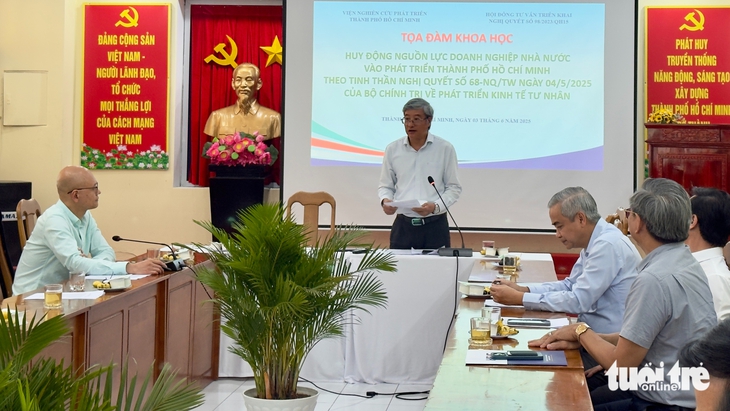
Representatives of the Ho Chi Minh City Institute for Development Studies (middle) receive opinions from economic experts and state-owned enterprise leaders, then make recommendations to the City People's Committee - Photo: BONG MAI
The scientific seminar "Mobilizing state-owned enterprise (SOE) resources for the development of Ho Chi Minh City in the spirit of Resolution No. 68 of the Politburo on private economic development" took place today, June 3, organized by the Ho Chi Minh City Institute for Development Studies.
There is a mentality of "fear" of high growth
From a global perspective, frankly looking at the truth, Dr. Tran Ngoc Anh (Indiana University, USA) said that the SOE model in many countries, including Vietnam, is facing many challenges in the context of fierce market competition.
A key reason lies in the dual role of SOE leaders, both as businessmen and politicians, leading to a situation where some people prioritize personal political goals over business efficiency.
For example, in our country, some state-owned construction corporations have invested widely in real estate and finance following trends, instead of focusing on core competencies, causing low efficiency and financial risks.
Notably, Dr. Ngoc Anh shared: "There is a mentality of "fear" of high growth, because this year's achievements will create pressure for the following years to achieve even higher growth, leading to the growth rate of many SOEs being quite slow."
Not to mention that the management is still heavy on administration and lacks flexibility. Meanwhile, the appointment process is sometimes more about procedures than market capacity.
Businesses are slow to invest due to concerns that initial accounting costs will affect profits. For example, technology upgrade projects in the mechanical engineering industry have been delayed for a long time.
The capacity of the leadership and management team becomes a major limitation, including: modern management capacity, the ability to promote technological innovation, implement digital transformation and expand international connections and cooperation.
Typically, the implementation of enterprise resource planning (ERP) systems at some state-owned corporations in Vietnam faces many difficulties, not only due to technological issues but also due to limited management and operational capacity.
Identifying the goals of existence and role, helping state-owned enterprises develop sustainably, and connecting well with the private economy
Mr. Pham Binh An - Deputy Director of the Ho Chi Minh City Institute for Development Studies - commented that with a rich practical foundation, Ho Chi Minh City has enough basis to proactively propose policies, remove obstacles in mechanisms and promote effective development of state-owned enterprises.
This process needs to be closely linked with the private sector and foreign-invested enterprises (FDI) to create more resonance and contribute to the overall development of the country.
"It is necessary to clearly define the existence goals and specific roles of SOEs," he emphasized. To do this, the city needs a specialized organization with high capacity to comprehensively review the operations of SOEs, including equitization, regional linkages and many related activities. From there, a clear picture can be obtained, helping to correctly identify the problem and come up with appropriate and effective solutions.
According to Dr. Tran Ngoc Anh, it is necessary to implement many breakthrough solutions to reform state-owned enterprises. Notably, it is necessary to establish a clear system of indicators (KPIs), including both financial and non-financial indicators. Assign specific and clear tasks to business leaders based on these indicators.
State-owned enterprises must be classified according to their operational objectives (strategic or competitive) to apply appropriate governance models. Professionalize the board of directors, separate the functions of state capital ownership and administrative management. Performance evaluation must be carried out by independent organizations to ensure objectivity. Equitization and divestment must be substantial, create an equal competitive environment, and eliminate unnecessary incentives.
Economists emphasize that if state-owned enterprises want to develop and thereby create momentum for the private economy to grow sustainably, they cannot ignore creating mechanisms to attract talent and encourage innovation and investment in technology.
Source: https://tuoitre.vn/doanh-nghiep-nha-nuoc-co-tam-ly-e-ngai-tang-truong-cao-20250603140700256.htm















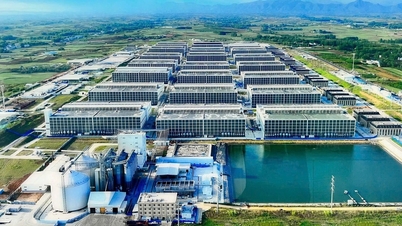


















































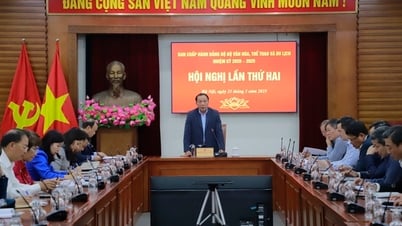




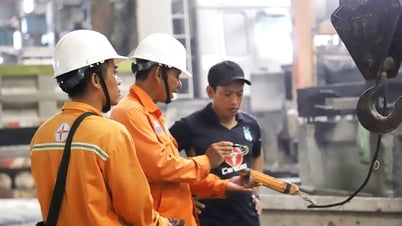


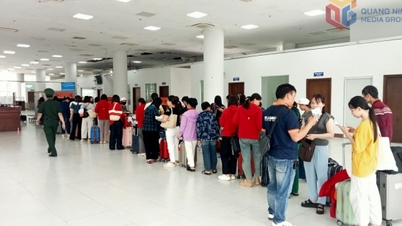







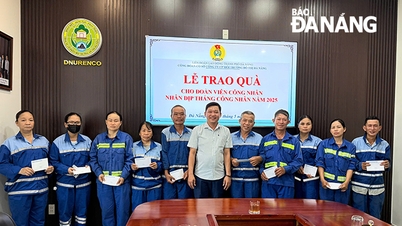









Comment (0)